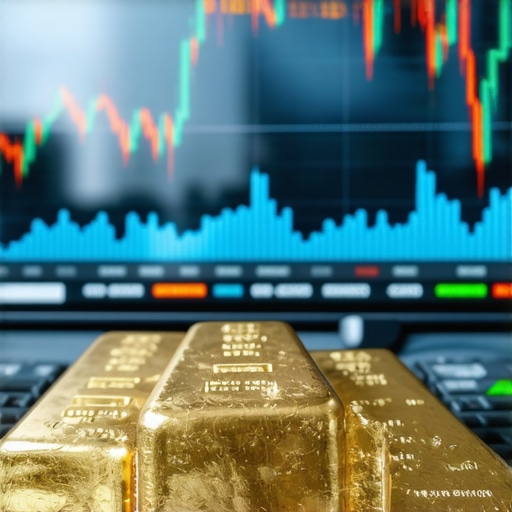Understanding Gold ETFs: An Essential Investment Tool
As we move into 2025, understanding gold ETFs (Exchange-Traded Funds) becomes increasingly crucial for investors looking to diversify their portfolios. Gold has long been viewed as a safe haven asset, particularly during times of economic uncertainty. With the potential for inflation and market volatility, gold ETFs offer a convenient way to invest in gold without the need for physical storage or security concerns. By purchasing shares in a gold ETF, investors can gain exposure to the price movements of gold while enjoying the liquidity and ease of trading that comes with stock-like instruments.
The Benefits of Investing in Gold ETFs in 2025
Gold ETFs come with several advantages that make them appealing to both novice and seasoned investors. Firstly, they provide instant diversification. Instead of buying individual gold coins or bars, which can be costly, a gold ETF allows you to invest in a diversified portfolio of gold assets. Additionally, these funds typically have lower expense ratios compared to traditional mutual funds, making them a cost-effective choice for many investors.
Moreover, gold ETFs can be bought and sold on major stock exchanges, providing flexibility that physical gold cannot offer. This means you can react quickly to market changes, making gold ETFs a strategic choice for active investors. For a deeper dive into the various types of gold investments, including ETFs, check out our post on Types of Gold Investments: Key Options to Consider.
Factors Influencing Gold ETF Performance in 2025
As with any investment, several factors will influence the performance of gold ETFs in 2025. Global economic conditions, interest rates, and geopolitical tensions are all critical elements that can drive gold prices up or down. For instance, when interest rates are low, the opportunity cost of holding non-yielding assets like gold decreases, often leading to higher demand and prices. Additionally, the ongoing economic implications of global events, such as the aftermath of the pandemic, will continue to shape investor sentiment towards gold.
Another aspect to consider is the role of central banks in the gold market. Many central banks have increased their gold purchases in recent years as a part of their strategy to diversify reserves. This trend can create upward pressure on gold prices, which in turn could benefit gold ETFs. Learn more about the implications of central bank gold purchases in our article on Understanding Central Bank Gold Purchases: What It Means.
Understanding Gold ETF Strategies for 2025
As we delve deeper into 2025, it’s essential to explore various strategies that can enhance your investment in gold ETFs. One popular approach is dollar-cost averaging, where investors buy a fixed dollar amount of gold ETFs at regular intervals. This strategy helps mitigate the impact of market volatility by reducing the risk of investing a large amount in a single lump sum. For further insights on investment strategies, consider reading our post on Investment Strategies for Buying Gold in Bull Markets.
Tax Implications of Gold ETFs
Investing in gold ETFs also has tax implications that investors should be aware of. In many jurisdictions, profits from gold ETFs are taxed as collectibles, which can result in higher capital gains tax rates compared to other investments. Understanding these tax ramifications is crucial for effective portfolio management. For a comprehensive overview of gold investment taxation, check out our guide on Understanding Gold IRA: A Secure Investment Choice.
Comparing Gold ETFs with Physical Gold
When considering gold investments, many investors often debate between gold ETFs and physical gold. Gold ETFs offer liquidity and ease of trading, while physical gold provides tangible assets. However, the costs associated with storage and insurance of physical gold can be significant. Investors should evaluate their personal preferences and investment goals when deciding between these two options. For a detailed comparison, refer to our article on Physical Gold Investment vs Digital: Pros and Cons.
Market Trends Affecting Gold ETFs in 2025
Several market trends are anticipated to influence gold ETFs in 2025. As inflation concerns rise and global economic uncertainty persists, the demand for gold as a safe-haven asset is expected to increase. Moreover, the evolving geopolitical landscape can impact gold prices significantly. Investors should stay informed about these trends to make educated decisions regarding their gold ETF investments. For more on current trends in the gold market, visit our post on Gold Market Analysis: Current Trends and Predictions.
Long-Term Outlook on Gold ETFs
The long-term outlook for gold ETFs remains positive, especially as more investors look to diversify their portfolios with alternative assets. Analysts suggest that as technology advances, gold ETFs will continue to evolve, offering more options for investors. Staying abreast of these developments will be essential for anyone involved in gold investments. For a future-focused perspective, explore our insights on 2025 Gold Market Analysis: Forecasts and Predictions.
Conclusion: Preparing for Your Gold ETF Investment Journey
As we progress through 2025, the importance of gold ETFs as an investment vehicle cannot be overstated. Whether you are a seasoned investor or just beginning your journey into the world of gold, understanding these instruments will equip you with the knowledge needed to navigate the complexities of the gold market successfully. Continuous learning and adaptation will be pivotal in maximizing your returns while managing risks effectively.
Advanced Strategies for Investing in Gold ETFs
As the landscape of gold investment evolves in 2025, investors are increasingly turning to advanced investment strategies to optimize their portfolios. One effective approach is the use of options trading on gold ETFs, which can provide additional flexibility and potential profits. By utilizing options, investors can leverage price movements while minimizing the risks associated with direct ownership of physical gold. To delve deeper into various trading strategies, refer to our article on Gold Trading Techniques for December: Streamline Your Approach.
Diversifying Within Gold Investments
Diversification is a crucial principle in investing, and this holds true for gold investments as well. Beyond traditional gold ETFs, investors can consider sector-specific ETFs that focus on gold mining companies or those that invest in gold-related equities. These options can provide exposure to the gold market while potentially enhancing returns through the performance of underlying stocks. To explore the best types of gold investments available today, check out our post on Evaluating the Best Types of Gold Investments Available.
Risk Management Techniques in Gold ETF Investing
Effective risk management is vital when investing in gold ETFs, particularly given the inherent volatility of the gold market. Investors should consider setting stop-loss orders to limit potential losses and protect their capital. Additionally, regularly reviewing and adjusting their investment allocations in response to market conditions can help maintain a balanced portfolio. For insights into navigating gold investment risks, visit our guide on Beginners Guide to Navigating Gold Investment Risks.
Utilizing Gold ETFs for Hedging Purposes
Gold ETFs can also serve as a powerful hedging tool against inflation and market downturns. By including gold ETFs in a diversified investment portfolio, investors can mitigate losses in other asset classes during turbulent economic times. This strategic move can enhance portfolio stability and protect wealth. To understand more about how gold acts as an effective hedge, read our post on The Best Gold Investment Strategies for Inflation Hedge.
Keeping an Eye on Market Indicators
For successful gold ETF investing, it’s essential to stay informed about key market indicators that influence gold prices. Economic data such as inflation rates, interest rate changes, and geopolitical events can significantly impact demand for gold. Investors should utilize resources that offer comprehensive gold market analysis to remain ahead of trends. To gain insights into current gold market dynamics, check our article on Gold Market Analysis: Current Trends and Predictions.
Exploring Future Gold Investment Opportunities
As we look toward the future, opportunities for growth within the gold market appear promising. With advancements in technology and changing investor preferences, new gold-related investment products may emerge. Keeping abreast of these developments will be crucial for investors aiming to capitalize on future trends. For a forward-looking perspective, explore our insights on 2025 Gold Market Analysis: Forecasts and Predictions.
Understanding the Role of Gold ETFs in Diversified Investment Strategies
As investors look to build diversified portfolios in 2025, gold ETFs play a pivotal role due to their unique characteristics. By integrating these funds into their investment strategies, individuals can hedge against market volatility and economic downturns. Gold ETFs not only offer the ability to capitalize on gold’s price movements but also provide a layer of protection against inflation, which is becoming increasingly vital in today’s economic climate. For an in-depth look at how inflation impacts gold investments, visit our article on The Best Gold Investment Strategies for Inflation Hedge.
Evaluating Performance Metrics for Gold ETFs
To make informed investment decisions, it’s essential to evaluate several performance metrics associated with gold ETFs. Key indicators include expense ratios, tracking error, and premium/discount to net asset value (NAV). Lower expense ratios typically indicate a more cost-effective investment, while tracking error demonstrates how closely the ETF follows the price of physical gold. Understanding these metrics can help investors select the best gold ETF that aligns with their financial goals. For a more comprehensive comparison of gold investments, check our post on Evaluating the Best Types of Gold Investments Available.
Sector-Specific Gold ETFs: A Deeper Dive
Investors should also consider sector-specific gold ETFs that focus on gold mining companies or other gold-related equities. These funds can provide exposure to the potential growth of mining operations, which can enhance overall returns. However, it’s crucial to weigh the risks, as these investments can be more volatile than traditional gold ETFs. To explore various types of gold investments and their implications, refer to our article on Types of Gold Investments: Key Options to Consider.
Impact of Global Economic Trends on Gold ETF Investments
In 2025, global economic trends will significantly influence gold ETF performance. Factors such as interest rates, currency fluctuations, and geopolitical events can sway investor sentiment and the demand for gold. For instance, rising inflation and economic instability often lead to increased demand for gold as a safe haven. Staying informed about these trends can help investors make strategic decisions regarding their gold ETF holdings. For insights into current trends affecting gold, visit our post on Gold Market Analysis: Current Trends and Predictions.
Long-Term Strategies for Gold ETF Investments
Long-term investment strategies can be beneficial for those looking to capitalize on gold’s enduring value. Implementing systematic investment plans, such as dollar-cost averaging, allows investors to build their positions gradually and reduce the impact of market fluctuations. Additionally, regularly reviewing and adjusting the portfolio based on market conditions is vital for maintaining alignment with investment goals. For further guidance on effective investment strategies, consider reading our post on Investment Strategies for Buying Gold in Bull Markets.
Conclusion: Navigating the Future of Gold ETF Investments
As we move further into 2025, understanding the nuances of gold ETFs will be crucial for investors aiming to maximize their returns. With ongoing market developments and the potential for innovative investment products, staying informed and adaptable will be key to successful gold investing. Whether you are a novice or experienced investor, leveraging the insights and strategies discussed in this article will empower you to make informed decisions in the evolving landscape of gold investments.
FAQs About Gold ETFs in 2025
What are Gold ETFs and how do they work?
Gold ETFs, or Exchange-Traded Funds, are investment funds that track the price of gold. Investors can buy shares of these ETFs on stock exchanges, providing exposure to gold prices without needing to own physical gold. They work by holding a quantity of gold bullion or gold-related assets, and the value of the ETF shares fluctuates in accordance with the price movements of gold.
Are Gold ETFs a safe investment?
Gold ETFs are generally considered a safer investment compared to physical gold due to their liquidity and transparency. However, like all investments, they carry risks. Market volatility, economic conditions, and changes in investor sentiment can affect their value. Investors should assess their risk tolerance and investment goals before investing.
How do Gold ETFs compare to physical gold?
Gold ETFs offer the advantage of liquidity and ease of trading, while physical gold provides a tangible asset. However, investing in physical gold entails costs related to storage and insurance. For those who prefer a hands-off approach, gold ETFs may be more suitable as they eliminate concerns regarding physical storage.
What are the tax implications of investing in Gold ETFs?
In many jurisdictions, profits from gold ETFs are taxed as collectibles, which can lead to higher capital gains tax rates compared to other investments. It’s essential for investors to understand the tax implications in their area to manage their investment returns effectively.
Can I use Gold ETFs for retirement savings?
Yes, Gold ETFs can be included in retirement accounts, such as IRAs, allowing investors to benefit from gold investment while enjoying tax advantages. It’s important to consult with a financial advisor to understand the rules and regulations surrounding Gold ETFs in retirement accounts.
What factors should I consider when choosing a Gold ETF?
When selecting a Gold ETF, consider performance metrics such as expense ratios, tracking errors, and the underlying assets’ quality. Additionally, assess the fund’s management and how closely it tracks the price of gold. This evaluation will help ensure that the ETF aligns with your investment strategy.
What are sector-specific Gold ETFs?
Sector-specific Gold ETFs focus on gold mining companies or related equities, providing exposure to the growth potential of these sectors. While they can offer higher returns, they also come with increased volatility compared to traditional gold ETFs. Investors should weigh the risks and rewards accordingly.
How can I effectively manage risks in Gold ETF investing?
Effective risk management strategies for Gold ETF investing include setting stop-loss orders to limit potential losses, regularly reviewing and adjusting your portfolio, and diversifying within different types of gold investments. These practices can help mitigate risks and enhance your investment outcomes.
What are the benefits of using Gold ETFs for hedging?
Gold ETFs can serve as an effective hedge against inflation and market downturns. By including gold in a diversified portfolio, investors can protect their wealth and mitigate losses in other asset classes during economic turmoil.
Authority Resources for Gold ETF Investing
To further deepen your understanding of Gold ETFs, consider exploring the following trusted resources:
- SPDR Gold Shares – One of the largest gold ETFs, providing insights into gold investment.
- World Gold Council – Offers research and data on gold markets and investment trends.
- Investopedia: Gold ETF – An educational resource providing comprehensive information about Gold ETFs.
- Morningstar – Provides analysis and ratings of various investment funds, including Gold ETFs.
- U.S. Securities and Exchange Commission (SEC) – The official site for regulations and guidelines surrounding ETFs.
Conclusion: Embracing Gold ETFs as a Strategic Investment
As we look ahead in 2025, Gold ETFs remain a significant investment vehicle for those seeking to diversify their portfolios and hedge against economic uncertainties. By understanding the mechanics, risks, and benefits associated with Gold ETFs, investors can make informed decisions that align with their financial goals. Embracing these insights and strategies will empower investors to navigate the complexities of the gold market effectively and optimize their investment journeys.










